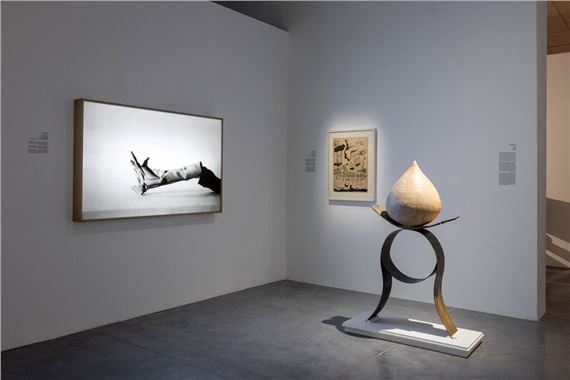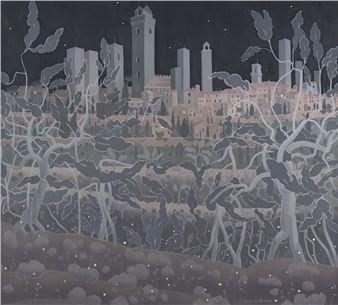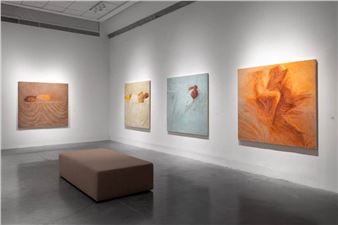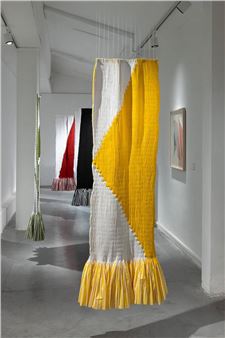Saturn Syndrome
The expression ‚Äúwritten in the stars‚ÄĚ reflects the cultural, emotional, and psychological bond between man and the celestial bodies, illustrating the notion of ‚Äč‚Äčfate as prescribed, shaped by the stars‚Äô metaphysical pull. Throughout the ages‚ÄĒfrom the early astronomy of ancient Greece and Rome, through the astronomical breakthroughs made in the Arab world and the innovations of the European Renaissance, to Jewish esoteric thought‚ÄĒsymbolic associations and philosophical meditations have flourished, linking the planet Saturn with the melancholic disposition. One of the slower planets in its orbit around the sun, Saturn has long been associated with qualities of heaviness and rumination, presiding over this exhibition as a cosmic emblem of melancholy‚Äôs shifting nature.
According to ancient astrology, the melancholic soul is governed by the motion of Saturn, encircled by its rings like an infinite loop‚ÄĒa cyclical movement of compressed time‚ÄĒyet it is also influenced by the cold, dry earth, fixed at the unmoving center of the celestial canopy. This distinction/dualism was linked to the theory of the four humors, which sought to explain illness as the result of an imbalance in one or more of the body‚Äôs fundamental fluids: red (blood), white (phlegm), yellow (bile), and black bile (melaina chole). The latter was associated with the melancholic temperament‚ÄĒa disposition toward dejection, withdrawal, and introspection, but also profound intellect, creative genius, and perfectionism. Over time, the concept of ‚Äč‚Äčmelancholy took on gendered overtones, seen as a masculine trait, in contrast to the lesser-regarded sadness or depression, often relegated to the feminine realm.
Italian humanist and philosopher Marsilio Ficino (1433‚Äď1499) diagnosed himself as saturnine from birth, describing this type as striving for the sublime and transcendent, while delving into the abysses of existence. Those of a Saturnine disposition, he believed, are haunted by an acute awareness of time‚Äôs passing and the impermanence of life, in contradistinction to the unchanging eternity of the divine. Ficino, who made no distinction between philosophy, religion, and mysticism, sought to fuse all the branches of knowledge into a holistic totality. He elevated melancholy from a condition of darkness to a potential wellspring of creativity and inner illumination. For Ficino, melancholy was no longer a mental disorder, but a state in which human talent could break free of tradition‚Äôs constraints and shackles, and a sign of spiritual depth and power, embodied in the figure of the philosopher king who seeks to comprehend the true nature of the cosmos. On the one hand, melancholy was seen as a divine gift and a mark of greatness; on the other, it carried danger, poised on the thin line between madness and genius.
Albrecht D√ľrer‚Äôs renowned engraving, Melencolia I (1514), is often interpreted as a spiritual-psychological self-portrait of the artist. It depicts a winged figure, a personification of Melancholy, in self-absorbed inaction, surrounded by carpentry tools, an hourglass, a sphere, and other geometric shapes‚ÄĒobjects and instruments linked to artistry, science, knowledge, and time. The figure leans heavily on her hand, her face pensive, frozen in gloom. D√ľrer conveys the complexity of the melancholic state‚ÄĒthe struggle between the soul‚Äôs yearning for the sublime and the decline of creative power.
Early in the modern era, in Europe, Robert Burton‚Äôs treatise The Anatomy of Melancholy (1621) compiled medical, philosophical, and astrological knowledge concerning melancholia as a disorder, including Saturn‚Äôs decisive influence on the melancholic temperament. The frontispiece of the book‚Äôs 1628 edition presented an allegorical depiction of ten melancholic states, with Saturn looming above. Among them, the Hypochondriac echoed the posture of D√ľrer‚Äôs figure.
The poetic image of Saturnian melancholy has endured through the centuries, and the bond forged in ancient astronomy, combining astrology, psychology, and myth, has left a lasting imprint on language, art, and literature. The archetype of the ‚Äútormented‚ÄĚ artist or thinker, whose melancholic soul oscillates between suffering and creation, was prevalent in both Romanticism and modern culture. In Jewish mysticism, the Talmudic Sages reflected on the fate of those born under Saturn‚Äôs sign: ‚ÄúHe who is born under Zedek (Jupiter) will be a right-doing man (zadkan) [‚Ķ]. He who is born under Mars (Ma‚Äôadim) will be a shedder of blood (damim),‚ÄĚ while ‚ÄúHe who is born under Saturn will be a man whose plans will be frustrated‚ÄĚ (Babylonian Talmud, Tractate Shabbat, 156a). In this context, the ghost of the false messiah, Sabbatai (Hebrew for Saturn) Sevi, is inescapable. Some scholars suggest he suffered from profound melancholy, delivering his proclamations in moments of enlightenment, when he believed himself to be a divine emissary.
Melancholy, then, is a continual movement between the longing for redemption and a fall into illusion. In the exhibition, it emerges as a personal trait and as an essential element for artistic expression, echoing contemporary art‚Äôs historical and mythical undercurrents. The featured works are marked by an intimate view of pain, which is perceived as symbolic capital and a catalyst for creation. They explore the romantic attraction to the darker depths of the soul/psyche‚ÄĒthe lure into realms of the unconscious that bind us in destructive patterns, yet simultaneously give rise to sublime insights.

Recommended for you
The expression ‚Äúwritten in the stars‚ÄĚ reflects the cultural, emotional, and psychological bond between man and the celestial bodies, illustrating the notion of ‚Äč‚Äčfate as prescribed, shaped by the stars‚Äô metaphysical pull. Throughout the ages‚ÄĒfrom the early astronomy of ancient Greece and Rome, through the astronomical breakthroughs made in the Arab world and the innovations of the European Renaissance, to Jewish esoteric thought‚ÄĒsymbolic associations and philosophical meditations have flourished, linking the planet Saturn with the melancholic disposition. One of the slower planets in its orbit around the sun, Saturn has long been associated with qualities of heaviness and rumination, presiding over this exhibition as a cosmic emblem of melancholy‚Äôs shifting nature.
According to ancient astrology, the melancholic soul is governed by the motion of Saturn, encircled by its rings like an infinite loop‚ÄĒa cyclical movement of compressed time‚ÄĒyet it is also influenced by the cold, dry earth, fixed at the unmoving center of the celestial canopy. This distinction/dualism was linked to the theory of the four humors, which sought to explain illness as the result of an imbalance in one or more of the body‚Äôs fundamental fluids: red (blood), white (phlegm), yellow (bile), and black bile (melaina chole). The latter was associated with the melancholic temperament‚ÄĒa disposition toward dejection, withdrawal, and introspection, but also profound intellect, creative genius, and perfectionism. Over time, the concept of ‚Äč‚Äčmelancholy took on gendered overtones, seen as a masculine trait, in contrast to the lesser-regarded sadness or depression, often relegated to the feminine realm.
Italian humanist and philosopher Marsilio Ficino (1433‚Äď1499) diagnosed himself as saturnine from birth, describing this type as striving for the sublime and transcendent, while delving into the abysses of existence. Those of a Saturnine disposition, he believed, are haunted by an acute awareness of time‚Äôs passing and the impermanence of life, in contradistinction to the unchanging eternity of the divine. Ficino, who made no distinction between philosophy, religion, and mysticism, sought to fuse all the branches of knowledge into a holistic totality. He elevated melancholy from a condition of darkness to a potential wellspring of creativity and inner illumination. For Ficino, melancholy was no longer a mental disorder, but a state in which human talent could break free of tradition‚Äôs constraints and shackles, and a sign of spiritual depth and power, embodied in the figure of the philosopher king who seeks to comprehend the true nature of the cosmos. On the one hand, melancholy was seen as a divine gift and a mark of greatness; on the other, it carried danger, poised on the thin line between madness and genius.
Albrecht D√ľrer‚Äôs renowned engraving, Melencolia I (1514), is often interpreted as a spiritual-psychological self-portrait of the artist. It depicts a winged figure, a personification of Melancholy, in self-absorbed inaction, surrounded by carpentry tools, an hourglass, a sphere, and other geometric shapes‚ÄĒobjects and instruments linked to artistry, science, knowledge, and time. The figure leans heavily on her hand, her face pensive, frozen in gloom. D√ľrer conveys the complexity of the melancholic state‚ÄĒthe struggle between the soul‚Äôs yearning for the sublime and the decline of creative power.
Early in the modern era, in Europe, Robert Burton‚Äôs treatise The Anatomy of Melancholy (1621) compiled medical, philosophical, and astrological knowledge concerning melancholia as a disorder, including Saturn‚Äôs decisive influence on the melancholic temperament. The frontispiece of the book‚Äôs 1628 edition presented an allegorical depiction of ten melancholic states, with Saturn looming above. Among them, the Hypochondriac echoed the posture of D√ľrer‚Äôs figure.
The poetic image of Saturnian melancholy has endured through the centuries, and the bond forged in ancient astronomy, combining astrology, psychology, and myth, has left a lasting imprint on language, art, and literature. The archetype of the ‚Äútormented‚ÄĚ artist or thinker, whose melancholic soul oscillates between suffering and creation, was prevalent in both Romanticism and modern culture. In Jewish mysticism, the Talmudic Sages reflected on the fate of those born under Saturn‚Äôs sign: ‚ÄúHe who is born under Zedek (Jupiter) will be a right-doing man (zadkan) [‚Ķ]. He who is born under Mars (Ma‚Äôadim) will be a shedder of blood (damim),‚ÄĚ while ‚ÄúHe who is born under Saturn will be a man whose plans will be frustrated‚ÄĚ (Babylonian Talmud, Tractate Shabbat, 156a). In this context, the ghost of the false messiah, Sabbatai (Hebrew for Saturn) Sevi, is inescapable. Some scholars suggest he suffered from profound melancholy, delivering his proclamations in moments of enlightenment, when he believed himself to be a divine emissary.
Melancholy, then, is a continual movement between the longing for redemption and a fall into illusion. In the exhibition, it emerges as a personal trait and as an essential element for artistic expression, echoing contemporary art‚Äôs historical and mythical undercurrents. The featured works are marked by an intimate view of pain, which is perceived as symbolic capital and a catalyst for creation. They explore the romantic attraction to the darker depths of the soul/psyche‚ÄĒthe lure into realms of the unconscious that bind us in destructive patterns, yet simultaneously give rise to sublime insights.
Contact details


 ARTISTS
ARTISTS












